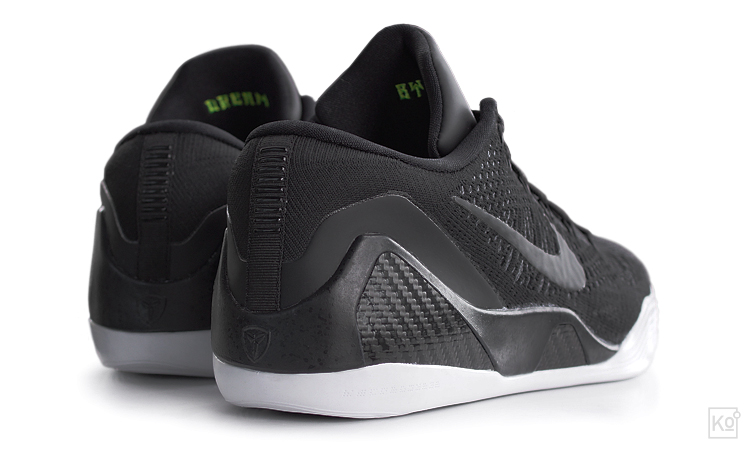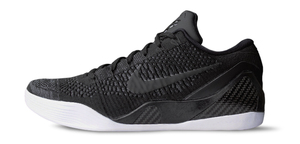The Kobe XI Elite is a fitting capstone to the Black Mamba’s storied on-court career.
When I wrote about the Kobe 9 Elite last January, I suggested it might be the last shoe that Bryant would wear in action as a professional in the Association. But, as all y’all already know, the Black Mamba proved doubters like myself wrong and has managed to will his battered body back for one more season—a season he kicked off in the Kobe X and will finish in his ultimate in-game shoe, the Kobe XI Elite. It’s clear that this final campaign won’t go down as among Bryant’s best, but, after spending time in the Kobe XI Elite, I’m convinced his final game shoe will nonetheless be remembered as a high point in a signature line that’s changed the shape of basketball footwear.
figure 1. Really, what is there to say—the Nike Kobe XI Elite is a stunner. As you can see on the tag affixed to the collar lining in the shot above, this is a colorway I created via NIKEiD. You’ll pay beaucoup bucks for the privilege, but the results can be pretty damn compelling.
I know a lot of people will disagree vehemently with me on this, but I think it’s a matter of fact that no signature shoe line has done more to change the fundamental silhouette of basketball footwear than Kobe’s eleven namesake models. Okay, okay, after you’re done yelling at your screen and rage tweeting me, hear me out because I know what you’re thinking: “Clearly, you’re forgetting about a certain Air Jordan line, you dumb ass.”
I acknowledge that the sixteen signature models that MJ donned for in-game action did more to change the aesthetic of athletic footwear than any other line of shoes, before or since. But let’s compare MJ’s first shoe, the Air Jordan I, with the last he would wear on court, the Air Jordan XVIII: Both were cut high around the ankle; both were fashioned with cut-and-sew leather uppers; and, while the XVIII featured double-lasted construction (meaning its upper was wrapped over its midsole, obscuring the midsole from view), both were built on the same basic architecture of outsole cemented to midsole and topped off with a thin foam sockliner.
figure 2. This is where Bryant’s signature collection with Nike officially kicked off back in 2005: The Nike Zoom Kobe I. Pictured here is the Midnight Navy/White-Varsity Red colorway, better known as the USA. It drew heavily from the shoe Bryant had worn the year prior, the Air Zoom Huarache 2K5, but with a streamlined upper and more extensive use of carbon fiber. It retailed for $130 when it launched, which translates to just under $160 in today’s dollars. It was a fantastic playing shoe and would, I think, compare favorably to many of the hoops offerings on the market today from a performance perspective.
There’s no question that the XVIII delivered significant advances in performance and comfort—for example, its midsole featured a full-length Zoom Air unit supplemented with an additional Zoom Air unit under the heel for incredibly responsive cushioning, and its sockliner was augmented with a molded carbon fiber “control plate” for added support—but I would argue that these advances were evolutionary in nature. To cite an analogous example from another industry, compare today’s Ford Mustang to the original introduced in 1964 and, while the 2016 model clearly offers major improvements versus its progenitor, you can draw a straight line between the two because their fundamental architectures have remained the same. This same sort of through line is evident across the Jordan collection.
Now let’s compare Kobe’s first signature shoe from Nike, the Zoom Kobe I, to the Kobe XI Elite: The ZK I offered a traditional mid-height cut around the ankle, while the XI Elite is cut as low as a running shoe; the I’s upper was formed from leather and assembled with traditional cut-and-sew techniques, while the XI Elite is almost entirely fabricated from a single layer of engineered Flyknit; and, down below, the I featured a conventional outsole-midsole-sockliner stack, while the XI is built on a removable midsole insert that forgoes a separate sockliner and can be customized via NIKEiD. In short, the Kobe XI Elite represents a fundamental break from its origins; as compared to the Zoom Kobe I, it manifests a wholly different concept of what a basketball shoe can and should be.
figure 3. Nike’s Kobe line has changed in fundamental ways from its start with the Zoom Kobe I to its latest incarnation in the Kobe XI Elite. Along the way, it’s also changed many ballers’ definitions of what a basketball shoe can and should be. To my eyes and feet, the magnitude of this shift is as profound as the leap made by BMW from their flagship 8 Series launched in 1989 to the current generation i8 flagship launched in 2014. Both the XI Elite and i8 represent breaks from the past and bold statements of intent for the future.
Returning, once again, to the automotive world for an analogy, this is akin to the paradigm shift that breaks the line between BMW’s flagship 8 Series coupe introduced in 1989 and its modern-day counterpart, the i8. Where the 8 Series was built on a conventional steel frame and body, the i8 features a core of carbon fiber onto which injection molded plastic panels are draped to form the body shell; and where a gas guzzling V-12 engine motivated the original 850i, the i8 is motivated by a tiny turbocharged 3-cylinder engine that’s augmented with two small electric motors. As for performance, the 850i’s giant V-12 could propel the car from 0 - 60 in about six seconds, but consumed 16 mpg combined in the bargain. By comparison, the i8’s puny powerplant rockets the car from 0 - 60 in about four seconds and sips a miserly 76 mpge. That’s what I call paradigm shifting progress.
Of course, both the 850i and i8 are cars, both come with two doors and both feature BMW’s signature roundel on the hood, but that’s about where their similarities end. In a similar sense, the Kobe XI Elite shares a Swoosh and a namesake athlete with the shoe that kicked off the series, but that’s essentially the extent of their kinship. If anything, the Kobe XI has more in common with the Nike Mercurial soccer boot and Nike Free Rn Distance runner than it does with the Zoom Kobe I.
figure 4. As you can see clearly in this image, the Kobe XI Elite is very much a true low-top. And yet, thanks to the exceptional containment provided by its upper, its relatively low-profile midsole and its artfully designed outsole—complete with outriggers alongside the lateral forefoot and cuboid regions of the foot—it feels reassuringly stable during hard cuts.
Visually, the difference between the Zoom Kobe I and Kobe XI Elite is most obvious in profile view. Any baller playing at an elite level back in 1985—the year the Air Jordan I was introduced—would think you were pulling a practical joke if you showed him the Kobe XI Elite and told him it was a performance hoops shoe. Back then, the high-cut ankle collar defined the look and feel of basketball footwear, and the Air Jordan line did little to challenge that convention over the span of Jordan’s career. Yes, low-top versions of MJ’s game shoes have always been a thing, but His Airness only wore those drop-top variants in a handful of games. By contrast, the low-top Kobe XI Elite is the shoe—it’s what Bryant wears on court and Nike does not offer a higher cut alternative.
But it’s not only in profile that the Kobe XI Elite defines a new silhouette for hoops. Look at the shoe from above—what industry folks refer to as the “toe-down” view—and you’ll notice that it wraps around the foot in a way that’s more akin to a form-fitting soccer cleat than a conventionally clunky basketball shoe. In most all hoops shoes today, the bottom unit (i.e. the combination of the midsole and outsole) is clearly visible from toe-down view because it protrudes out beyond the perimeter of the upper. But look at the Kobe XI Elite from above and its outsole is barely visible. More so than any other basketball shoe on the market today, the bottom dimensions of the Kobe XI Elite actually reflect the bottom dimensions of your foot, which is a large part of the reason why the shoe has been so consistently praised for its natural, agile feel.
figure 5. It’s not only in profile that the Kobe XI Elite defines a new silhouette for hoops. Look at the shoe from above—what industry folks refer to as the “toe-down” view—and you’ll notice that it wraps around the foot in a way that’s more akin to a form-fitting soccer cleat than a conventionally clunky basketball shoe. I think this sleek fit contributes to the XI Elite’s agile, natural feel on court.
Another important contributor to the Kobe XI Elite’s exceptional on-court ride is its drop-in midsole. The concept of an interchangeable midsole is something both Nike Basketball and Brand Jordan have experimented with off-and-on since its February 2011 debut in the Air Jordan 2011 and subsequent application in the “Kobe VII System” later that same year. To my feet, the implementation in the Kobe XI Elite is the best yet in that it does a great job balancing the often dueling benefits of comfort, court feel, impact attenuation and responsiveness. Two big upgrades from the insert featured in the aforementioned Kobe IX are the inclusion of a top cloth, which presents a more pleasant interface for your sock-shod feet, and the addition of a Zoom Air unit under the heel. Even as a fan of Nike’s Lunarlon foam, I appreciated the added bounce delivered by Zoom.
figure 6. The concept of an interchangeable, “drop-in” midsole isn’t new—it debuted in the Air Jordan 2011 and first appeared in the Kobe line later that same year—but, to my feet, the implementation in the Kobe XI Elite is the best yet. It does a great job balancing the often dueling benefits of comfort, court feel, impact attenuation and responsiveness, and introduces the added benefit of customization. Pictured here is the “Responsive Full Length Zoom” drop-in, which offers fantastically springy cushioning that lasts. Bear in mind, though, that this full-length Zoom option demands a $20 premium over the existing $45 uncharge associated with the Kobe XI Elite iD, meaning your wallet will be $265 lighter after all is said and done. Even as a big fan of the shoe, that’s tough to justify.
I should note that those specs I just cited describe the midsole that comes with the stock version of the Kobe XI Elite. Those of a more persnickety nature can customize the insert via NIKEiD, though you’ll pay dearly for the privilege. The iD version of the XI Elite starts at an eye-watering $245—a $45 premium over the already stratospherically priced “base” model.
Aside from the typical aesthetic tweaks available to those with fat wallets, the XI Elite iD offers three midsole cushioning options: the stock Lunarlon + heel Zoom version, Lunarlon with no heel Zoom for those who prefer straight foam, and an ultra-primo version with a full-length Zoom Air unit. That last option will set you back an additional $20—do the math and that adds up to a total cost of $265. As someone who’s always lived by the credo: “Why spend tomorrow what you can spend today?,” I had to go the full-length Zoom route. And I do love actually being able to feel the springy-ness of Zoom Air under the full length of my foot, but, damn, that’s a hell of a lot of coin to drop on a shoe that might not make it through a full season of play (certainly not if you spend any amount of time balling outdoors).
figure 7. Beautiful outsoles have been a hallmark of the Kobe line, and the Kobe XI Elite’s rubber holds to that tradition. What I particularly like about this iteration is the artful blending of lateral outriggers along both the forefoot and cuboid regions of the foot. This is a very elegant way to enhance lateral stability without adding a lot of bulk or weight to the shoe. I haven’t spent enough time playing in the XI Elite myself to comment on traction, but the performance reviews I’ve read suggest that it can vary greatly based on your playing surface, with the XI’s tread not faring particularly well on dusty courts.
There’s a lot more I could write about the Kobe line in general and the Kobe XI Elite in particular, but I suspect I’ve already gone on far longer than most would care to read. The fact that it’s the last shoe Bryant will wear as a pro cements its claim to a spot in sneakerhead history by default. But as someone who’s into kicks for their performance and engineering, I believe the XI earns that recognition. I noted above that the specifics of form and execution have changed dramatically from the Zoom Kobe I to the Kobe XI Elite, but what holds the line together as a collection is that they all reflect Bryant’s singular commitment to performance. Look over each successive model in the line and you see this commitment getting sharper and sharper—unnecessary layers being stripped away, unnecessary components being shown the door—until all you’re left with are the elements essential to peak performance. That commitment is what made Bryant a great player and it’s what makes the Kobe XI Elite a great shoe.
Agree? Disagree? Have questions? Let’s continue the conversation on Twitter @edotkim.
Who’s Worn It:
Kobe Bryant (G- Los Angeles Lakers); DeMar DeRozan (G- Toronto Raptors); Jrue Holiday (G- New Orleans Pelicans); LeBron James (F- Cleveland Cavaliers); Stanley Johnson (F- Detroit Pistons); Zach LaVine (G- Minnesota Timberwolves); Isaiah Thomas (G- Boston Celtics); P. J. Tucker (F- Phoenix Suns); John Wall (G- Washington Wizards)
















